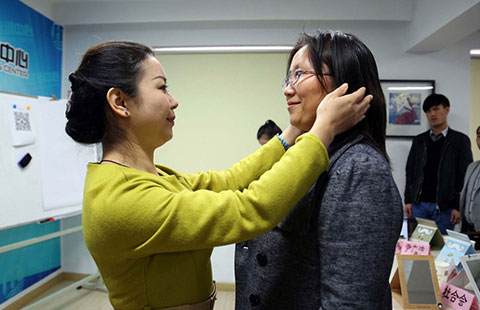More Chinese to travel overseas to seek better medical treatment
By WANG YING (China Daily) Updated: 2015-07-06 07:52After spending about two months in California receiving medical treatment and recovering, 64-year-old Wu Ming finally bounced back to health.
Wu started to feel physical discomfort in 2012, but an examination in a local hospital in Shanghai showed nothing abnormal. It wasn't until September 2013 that he was diagnosed with late-stage prostate cancer.
Learning that traditional treatment would do little to the disease, Wu turned to Shanghai-based MEGA Healthcare in September 2014, and two months later received a particle therapy treatment in the United States.
Founded in March 2013, MEGA Healthcare helps people receive medical treatment overseas. Across China, the number of such agencies is nearly 30.
Wu is but one of an increasing number of Chinese willing to pay more for overseas healthcare and treatment. The number of people going abroad for medical treatment has doubled to 40 million in six years since 2006, and in 2013, their total spending reached $438.6 billion. This made up 14 percent of the global tourism industry, according to Xinhuanet.com, citing a survey released by the Stanford Research Institute in the US.
Chinese visits to South Korea for medical treatment soared nearly 17 times to 79,481 in five years from 2009 to 2014, the Chinese version of South Korean AJU Business Daily reported.
Chinese patients spent 140.3 billion South Korean won ($126.6 million) in 2014. They also topped the foreign patients list ahead of visitors from Russia, the US and the United Arab Emirates.
Other places are proving just as popular.
Wang Ting has taken vaccines every year since 2010 in Hong Kong to prevent cervical cancer.
"I learned this vaccine will be most effective if it is taken at age 26, but it is only available in Hong Kong or Taiwan," said the 31-year-old magazine editor.
Japan has also become a key destination for Chinese patients.
"I arranged a membership medical examination for my father in April in Japan. I think the service from professional doctors is worth the high cost," said 32-year-old Tian Yuxin.
Tian herself also plans to have a physical exam in Japan in August.
So far, there is no official statistics indicating how many Chinese people go overseas for healthcare service, but it's true that quite a few foreign medical facilities are extending their business to the Chinese market.
Chen Jiaye and her family went to the US for a one-month tour last year, and she spent around 20,000 yuan ($3,227) for a physical examination in Los Angeles.
"The feeling of getting a one-on-one health service is so good, and the doctor patiently asked many questions and provided quite a few advice for a healthy diet," said 36-year-old Chen, who is considering doing regular health checks abroad in the future.
At least 3,000 people went to the US for medical reasons from Shanghai Customs alone in 2013, according to Fan Tailai, general manager of MEGA Healthcare.
"The actual number should be more than that. As newvisas are valid for 10 years, people can go on a medical tour even if their visas are for pure travel or visiting reasons," Fan said.
Average cost for getting medical treatment in the US is about $150,000, and most of the Chinese patients come from major cities such as Beijing and Shanghai.
"There are only three or four agencies offering similar services when we established the company in China, and we had only several customers (who went to the US for treatment) in the first year," said Guo Liang, executive director and co-founder of MEGA Healthcare.
The doctor-turned-entrepreneur said he and his family members had similar terrible experience in crowded Chinese hospitals as many other Chinese people.
"My experience of being a doctor let me understand their high pressure of seeing dozens of patients every day, but at the same time, I also see a rising demand for a better treatment environment for patients," said Guo.
This is the reason why he and his partners decided to open a medical service agency for Chinese people.
"I used to think every hospital is the same-noisy, crowded, and you have to take off your pants in front of everybody in the room when you are given an injection," said Cai Qiang, founder and president of Beijing Saint Lucia Hospital Management Consulting Co.
"But when I moved to Australia, I saw a completely different scene in the hospital-the building looked like a starhotel, and there were special rooms for the doctor and the patient to use when taking an examination. When my wife gave birth to our baby, the doctor even prepared a camera for us," Cai said.
Cai said he was shocked by the stark contrast and decided to go back to China in 2009 to help Chinese patients receive overseas medical treatment.
In 2011, Saint Lucia became the nation's first provider of overseas medical care, and it is now the largest in this area with nearly 1,000 clients receiving either a long-distance medical consultation or medical treatment overseas.
In 2014, Saint Lucia received more than 10 million yuan investment from Sequoia Capital, an American venture capital firm located in Menlo Park, California.
Now more and more Chinese people realize there is an alternative solution to health care, and the industry is recognized as high potential.
"Although this is a niche market, I believe it will grow rapidly in the coming years," Guo from MEGA said.
Cai Jiangnan, director of center for healthcare management and policy with China Europe International Business School, said well-moneyed professionals or entrepreneurs go for overseas healthcare services for three reasons-better medical environment and service, state-of-the-art technology and the latest medicine that is not yet available in China.
Yu Ran in Shanghai contributed to this story.
- 2015 China International Fair for Investment and Trade kicks off in Xiamen
- China's commodity imports robust in Jan-Aug period
- China stocks rebound 2.92%
- 2015 China box office already past 2014 total
- China foreign trade decline widens in August
- Interview: JP Morgan's senior executive bullish on China
- Innovation, development the focus for NZ mayors
- Lives of freelancers

















